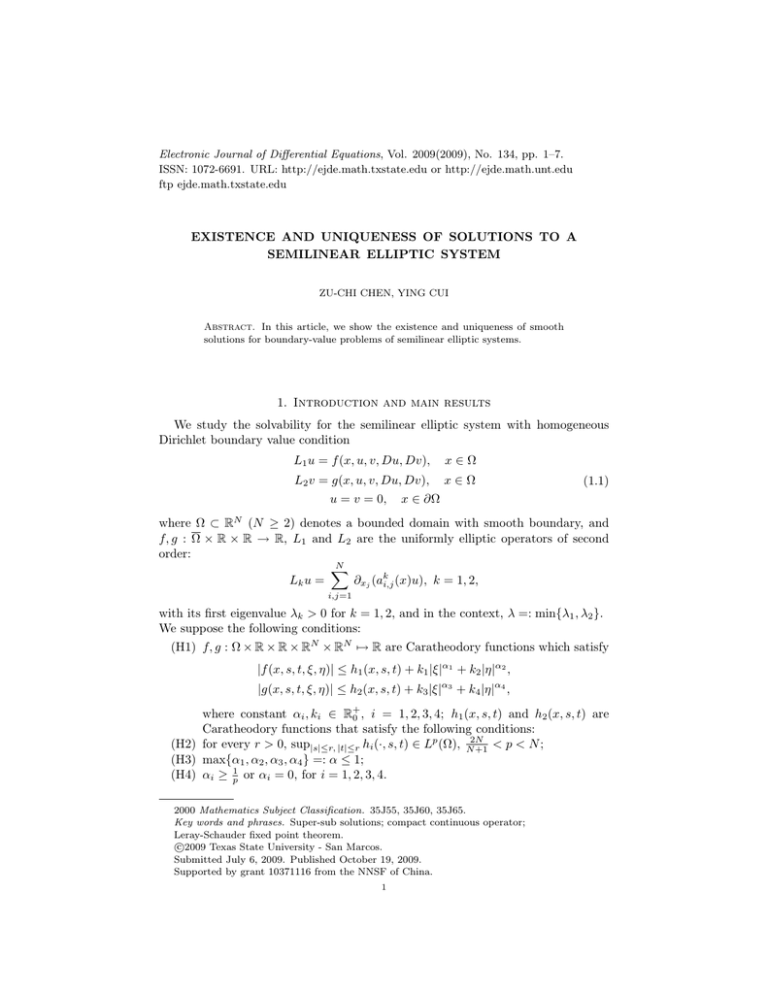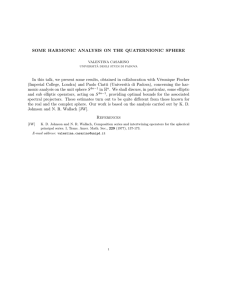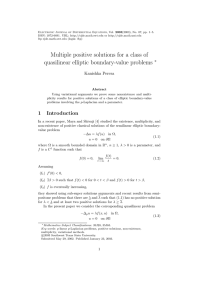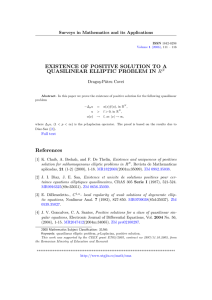Electronic Journal of Differential Equations, Vol. 2009(2009), No. 134, pp.... ISSN: 1072-6691. URL: or
advertisement

Electronic Journal of Differential Equations, Vol. 2009(2009), No. 134, pp. 1–7.
ISSN: 1072-6691. URL: http://ejde.math.txstate.edu or http://ejde.math.unt.edu
ftp ejde.math.txstate.edu
EXISTENCE AND UNIQUENESS OF SOLUTIONS TO A
SEMILINEAR ELLIPTIC SYSTEM
ZU-CHI CHEN, YING CUI
Abstract. In this article, we show the existence and uniqueness of smooth
solutions for boundary-value problems of semilinear elliptic systems.
1. Introduction and main results
We study the solvability for the semilinear elliptic system with homogeneous
Dirichlet boundary value condition
L1 u = f (x, u, v, Du, Dv),
x∈Ω
L2 v = g(x, u, v, Du, Dv),
x∈Ω
u = v = 0,
(1.1)
x ∈ ∂Ω
where Ω ⊂ RN (N ≥ 2) denotes a bounded domain with smooth boundary, and
f, g : Ω × R × R → R, L1 and L2 are the uniformly elliptic operators of second
order:
N
X
Lk u =
∂xj (aki,j (x)u), k = 1, 2,
i,j=1
with its first eigenvalue λk > 0 for k = 1, 2, and in the context, λ =: min{λ1 , λ2 }.
We suppose the following conditions:
(H1) f, g : Ω × R × R × RN × RN 7→ R are Caratheodory functions which satisfy
|f (x, s, t, ξ, η)| ≤ h1 (x, s, t) + k1 |ξ|α1 + k2 |η|α2 ,
|g(x, s, t, ξ, η)| ≤ h2 (x, s, t) + k3 |ξ|α3 + k4 |η|α4 ,
where constant αi , ki ∈ R+
0 , i = 1, 2, 3, 4; h1 (x, s, t) and h2 (x, s, t) are
Caratheodory functions that satisfy the following conditions:
(H2) for every r > 0, sup|s|≤r, |t|≤r hi (·, s, t) ∈ Lp (Ω), N2N
+1 < p < N ;
(H3) max{α1 , α2 , α3 , α4 } =: α ≤ 1;
(H4) αi ≥ p1 or αi = 0, for i = 1, 2, 3, 4.
2000 Mathematics Subject Classification. 35J55, 35J60, 35J65.
Key words and phrases. Super-sub solutions; compact continuous operator;
Leray-Schauder fixed point theorem.
c
2009
Texas State University - San Marcos.
Submitted July 6, 2009. Published October 19, 2009.
Supported by grant 10371116 from the NNSF of China.
1
2
Z. CHEN, Y. CUI
EJDE-2009/134
Theorem 1.1. Assume (H1)–(H4). If (1.1) has two pairs of subsolutions and
supersolutions (u, u), (v, v), then (1.1) has at least one solution (u, v) ∈ [W 2,p (Ω) ∩
W01,p (Ω)]2 .
For the next theorem we need the assumption
(H5) f, g : Ω × R × R × RN × RN 7→ R are Lipschitz continuous, with Lipschitz
λ
coefficients l1 and l2 , and L := max{l1 , l2 } < 4C+1
, where C = C(n, p, Ω)
is the coefficient for the Poincaré inequality.
Theorem 1.2. Under Condition (H5), Problem (1.1) has at most one weak solution
(u, v) ∈ [W 2,p (Ω) ∩ W01,p (Ω)]2 , N2N
+1 < p < N .
2. The proof of Theorem 1.1
p
.
Proof. From (H2) and (H3), we know that [αp, p∗ ) is not empty, where p∗ = NN−p
∗
1,q0
1,q0
∞
Fix q0 ∈ [αp, p ), let T : W
(Ω) 7→ W
(Ω) ∩ L (Ω) be the cut-off function
about u, u, v, v; i.e.,
T u(x) = u(x),
T u(x) = u(x),
u ≤ u,
u ≤ u ≤ u,
T u(x) = u(x),
u ≤ u,
T v(x) = v(x),
v ≤ v,
T v(x) = v(x),
T v(x) = v(x),
v ≤ v ≤ v,
v ≤ v.
Next, we prove that T u, T v ∈ W 1,q0 (Ω) ∩ L∞ (Ω). Firstly, we notice that
|T u(x)| ≤ max{|u|, |u|} =: M,
a.e. x ∈ Ω,
|T v(x)| ≤ max{|v|, |v|} =: m,
a.e. x ∈ Ω
for every u, v ∈ W 1,q0 (Ω), then T u, T v ∈ L∞ (Ω). Since the embedding of W 2,p (Ω)
into W 1,q0 (Ω) is compact and u, u, v, v ∈ W 1,q0 (Ω), then by [8, A.6], we know
|u − v| ∈ W 1,q0 (Ω). Also, from
u + u + 2u − |u − u| |u + u − 2u − |u − u||
+
,
4
4
v + v + 2v − |v − v| |v + v − 2v − |v − v||
T v(x) =
+
4
4
1,q0
1,q0
we know that T u, T v ∈ W
(Ω), hence T u, T v ∈ W
(Ω) ∩ L∞ (Ω).
1,q0
2
1,q0
2
Let S : [0, 1] × [W
(Ω)] 7→ [W
(Ω)] be defined as S(t, u, v) = (w1 , w2 ),
where (w1 , w2 ) is the solution of the following boundary-value problem
T u(x) =
L1 w1 = tf (x, T u, T v, D(T u), D(T v)), x ∈ Ω,
w1 = 0, x ∈ ∂Ω,
L2 w2 = tg(x, T u, T v, D(T u), D(T v)), x ∈ Ω,
w2 = 0, x ∈ ∂Ω.
(2.1)
(2.2)
According to (H1)-(H4), for every u, v ∈ W 1,q0 (Ω), we have f, g ∈ Lp (Ω). Then,
based on [3, Theorem 6.4], (2.1) and (2.2) have a unique solution (w1 , w2 ) ∈
[W 2,p (Ω) ∩ W01,p (Ω)]2 which means that S is a well-defined operator. Obviously
EJDE-2009/134
EXISTENCE AND UNIQUENESS
3
S(0, u, v) = (0, 0), then by the Sobolev embedding theorem, W 2,p (Ω) ,→ W 1,q0 (Ω),
we know that S is continuous.
Next we prove that (u, v) ∈ [W 1,q0 (Ω)]2 , and for a certain t ∈ [0, 1], S(t, u, v) =
(u, v) and this (u, v) satisfies
kuk1,q0 + kvk1,q0 ≤ C.
According to the Sobolev embedding theorem and (H1), we have
kuk1,q0 ≤ Ckuk2,p
≤ C(kh1 (x, T u, T v)kp + k1 k|D(T u)|α1 kp + k2 k|D(T v)|α2 kp )
(2.3)
and
kvk1,q0 ≤ Ckvk2,p
≤ C(kh2 (x, T u, T v)kp + k3 k|D(T u)|α3 kp + k4 k|D(T v)|α4 kp ).
(2.4)
Then from the definition of T u and T v, and the condition (H2) we know that
khi (x, T u, T v)kp ≤ C,
i = 1, 2.
(2.5)
Where C depends only on u, u, v, v and p. When i = 1, 3, we have
αi
kDukαi p ] , u ≥ u
αi
αi
kD(T u) kp = [kD(T u)kαi p ] = [kDukαi p ]αi , u ≤ u ≤ u
[kDukαi p ]αi , u ≤ u.
(2.6)
When i = 2, 4, we have
||D(T v)αi ||p = [kD(T v)kαi p ]αi
αi
kDvkαi p ] , v ≥ v
= [kDvkαi p ]αi , v ≤ v ≤ v
[kDvkαi p ]αi , v ≤ v.
(2.7)
Then by [1, Theorem 4.14] (Ehrling-Nirenberg-Gagliardo), we obtain
kDukαi p ≤ k1 kuk2,αi p + k2 ()kukαi p , u ≤ u ≤ u,
kDvkαi p ≤ k3 kvk2,αi p + k4 ()kvkαi p , v ≤ v ≤ v.
(2.8)
Since u ≤ u ≤ u, v ≤ v ≤ v, αi ≤ 1, i = 1, 2, 3, 4, by αi p ≤ q0 and u, u, v, v ∈
W 1,q0 (Ω), we obtain
kukαi p ≤ C,
kDukαi p ≤ C,
kuk2,αi p ≤ Ckuk2,p ,
kvkαi p ≤ C,
kDvkαi p ≤ C,
kDukαi p ≤ C,
kDvkαi p ≤ C,
kvk2,αi p ≤ Ckvk2,p ,
(2.9)
i = 1, 2, 3, 4.
Without loss of generality, we assume that kuk2,p ≥ 1, kvk2,p ≥ 1. By (2.5), (2.6),
(2.7), (2.8), (2.9), we know from (2.3) and (2.4) that
kuk2,p + kvk2,p ≤ C1 ε(kuk2,p + kvk2,p ) +
Select ε =
1
2C1 ,
we can write
kuk2,p + kvk2,p ≤ C.
Then according to (2.3) and (2.4),
kuk1,q0 + kvk1,q0 ≤ C.
C
.
2
4
Z. CHEN, Y. CUI
EJDE-2009/134
From the Leray-Schauder fixed point theorem [7, Theorem 11.3], there exists a
solution (u, v) ∈ [W 1,q0 (Ω)]2 satisfying S(1, u, v) = (u, v); i. e.,
L1 u = f (x, T u, T v, D(T u), D(T v)),
x ∈ Ω,
L2 v = g(x, T u, T v, D(T u), D(T v)),
x ∈ Ω,
(2.10)
x ∈ ∂Ω.
u = v = 0,
Then (u, v) ∈ [W
(Ω)] implies f, g ∈ L (Ω) and (u, v) ∈ [W 2,p (Ω) ∩ W01,p (Ω)]2 .
Next we prove that (u, v) satisfies
1,q0
2
p
u ≤ u ≤ u, v ≤ v ≤ v.
Firstly we prove u ≤ u. Let w = u − u, then w ∈ W 2,p (Ω), define w+ (x) =
max{0, w(x)}, then we need only to prove w+ = 0. Previously,
L1 u = f (x, T u, T v, D(T u), D(T v)),
L1 u ≥ f (x, u, T v, Du, D(T v)).
We obtain the inequality
L1 w ≤ [f (x, T u, T v, D(T u), D(T v)) − f (x, u, T v, Du, D(T v))].
(2.11)
+
Multiply this inequality by w , and integrate on Ω. On the left-hand side, we have
Z X
Z
Z X
N
1
+
+
aij (x)Di ω · Dj ω −
a1ij (x)Di ω · ω +
L1 ω · ω =
Ω
∂Ω
Ω i,j=1
Z
=
N
X
a1ij (x)Di ω · Dj ω +
Ω i,j=1
Then we can rewrite (2.11) as
Z
Z X
N
a1ij (x)Di ω · Dj ω + ≤ [f (x, T u, T v, D(T u), D(T v))
Ω i,j=1
Ω
(2.12)
− f (x, u, T v, Du, D(T v))]w+ dx.
Let A = {x ∈ Ω : u(x) ≤ u(x)} and B = {x ∈ Ω : u(x) > u(x)}. Then
Ω = A ∪ B. Obviously on A, w+ = 0. In B, T u = u. Then the righthand side of
(2.12) is zero. That is,
Z X
N
a1ij (x)Di ω · Dj ω + = 0.
Ω i,j=1
On A, w+ = 0; on B, ω = ω + . We can write the previous equation as
Z
N
X
a1ij (x)Di ω + · Dj ω + = 0.
Ω+ i,j=1
Then according to the definition of the uniform elliptic operator,
Z
N
X
2
λ|Dω + | ≤
a1ij (x)Di ω + · Dj ω + = 0.
Ω+ i,j=1
Consequently, w+ = 0, x ∈ Ω. That is in Ω, u ≤ u. Similarly, we can prove that
u ≤ u and v ≤ v ≤ v. From the definition of T , we know T u = u and T v = v. Then
EJDE-2009/134
EXISTENCE AND UNIQUENESS
5
by (2.10), we obtain that (u, v) ∈ [W 2,p (Ω) ∩ W01,p (Ω)]2 is the solution of (1.1).
The proof is completed.
An example. In this section, we illustrate Theorem 1.1.
1
2λ1
u + v + λ1 φ1 |Du| 2 , x ∈ Ω,
9
√
1
3
3 32
λ2
λ2
L2 v = λ22 φ2 (x) + 2 u + v +
λ φ2 (x)|Dv| 2 , x ∈ Ω,
4
12
4
4 2
u = v = 0, x ∈ ∂Ω.
L1 u = λ1 φ1 (x) +
(2.13)
Here Ω is a regular domain in RN (N > 2) with smooth boundary ∂Ω, and
φi (x) =
ϕi (x)
≤ 1.
supΩ |ϕi | + supΩ |Dϕi |
In addition, λi > 0, ϕi (x) > 0 are the first eigenvalue and the corresponding eigenfunction of operator Li in Ω with zero-Dirichlet boundary value condition. Therefore,
Li φi (x) =
Li ϕi (x)
λi ϕi (x)
=
= λi φi (x).
supΩ |ϕi | + supΩ |Dϕi |
supΩ |ϕi | + supΩ |Dϕi |
When 2 < p < N , we can verify that problem (2.13) satisfies condition (H1)–(H4).
Let
u = 0;
v = 0;
u = 9φ;
v = 3λ1 φ;
φ = max(φ1 , φ2 ).
It is not difficult to verify that (u, u), (v, v), based on this definition, is a pair of
super-solution and sub-solution for problem(2.13). Hence according to Theorem
1.1, problem (2.13) has at least one solution (u, v) ∈ [W 2,p (Ω) ∩ W01,p (Ω)]2 .
3. The proof of Theorem 1.2
Proof. Assume (u1 , v1 ), (u2 , v2 ) ∈ [W 2,p (Ω) ∩ W01,p (Ω)]2 are solutions for problem
(1.1); therefore
L1 u1 = f (x, u1 , v1 , Du1 , Dv1 ),
x ∈ Ω,
L2 v1 = g(x, u1 , v1 , Du1 , Dv1 ),
x ∈ Ω,
u1 = v1 = 0,
x ∈ ∂Ω
and
L1 u2 = f (x, u2 , v2 , Du2 , Dv2 ),
x ∈ Ω,
L2 v2 = g(x, u2 , v2 , Du2 , Dv2 ),
x ∈ Ω,
u2 = v2 = 0,
x ∈ ∂Ω.
Then
L1 (u1 − u2 ) = f (x, u1 , v1 , Du1 , Dv1 ) − f (x, u2 , v2 , Du2 , Dv2 ),
(3.1)
L2 (v1 − v2 ) = g(x, u1 , v1 , Du1 , Dv1 ) − g(x, u2 , v2 , Du2 , Dv2 ),
(3.2)
(u1 − u2 ) |∂Ω = (v1 − v2 ) |∂Ω = 0.
(3.3)
6
Z. CHEN, Y. CUI
EJDE-2009/134
Multiply (3.1) by (u1 − u2 ) and (3.2) by (v1 − v2 ), and then integrate them on Ω
yield
Z
Z X
N
(u1 − u2 ) · L1 (u1 − u2 ) =
a1ij (x)Di (u1 − u2 ) · Dj (u1 − u2 ),
Ω
Ω i,j=1
Z
N
X
Z
(v1 − v2 ) · L2 (v1 − v2 ) =
Ω
a2ij (x)Di (v1 − v2 ) · Dj (v1 − v2 ).
Ω i,j=1
By the uniformly elliptic condition, we get
Z X
N
2
a1ij (x)Di (u1 − u2 ) · Dj (u1 − u2 ) ≥ λkDu1 − Du2 k ,
Ω i,j=1
N
X
Z
2
a2ij (x)Di (v1 − v2 ) · Dj (v1 − v2 ) ≥ λkDv1 − Dv2 k .
Ω i,j=1
Using the Lipschitz condition on f, g, it yields
Z
(f (x, u1 , v1 , Du1 , Dv1 ) − f (x, u2 , v2 , Du2 , Dv2 ))(u1 − u2 )dx
Ω
Z
≤ L (|u1 − u2 | + |v1 − v2 | + |Du1 − Du2 | + |Dv1 − Dv2 |) · |u1 − u2 |dx
Ω
2
Z
2
≤L
2
(3|u1 − u2 | + |v1 − v2 | +
Ω
2
|Du1 − Du2 | + |Dv1 − Dv2 |
)dx
2
and
Z
(g(x, u1 , v1 , Du1 , Dv1 ) − g(x, u2 , v2 , Du2 , Dv2 ))(v1 − v2 )dx
Z
≤ L (|u1 − u2 | + |v1 − v2 | + |Du1 − Du2 | + |Dv1 − Dv2 |) · |v1 − v2 |dx
Ω
Ω
2
Z
2
≤L
2
(|u1 − u2 | + 3|v1 − v2 | +
Ω
2
|Du1 − Du2 | + |Dv1 − Dv2 |
)dx.
2
Furthermore,
2
λkDu1 − Du2 k
Z X
N
≤
a1ij (x)Di (u1 − u2 ) · Dj (u1 − u2 )
Ω i,j=1
Z
2
≤L
2
(3|u1 − u2 | + |v1 − v2 | +
Ω
2
2
2
2
|Du1 − Du2 | + |Dv1 − Dv2 |
)dx
2
and
2
λkDv1 − Dv2 k
Z X
N
≤
a2ij (x)Di (v1 − v2 ) · Dj (v1 − v2 )
Ω i,j=1
Z
≤L
2
2
(|u1 − u2 | + 3|v1 − v2 | +
Ω
|Du1 − Du2 | + |Dv1 − Dv2 |
)dx.
2
EJDE-2009/134
EXISTENCE AND UNIQUENESS
7
Summing these two formulas yields
2
2
λkDu1 − Du2 k + λkDv1 − Dv2 k
Z
2
2
2
2
≤ L (4|u1 − u2 | + 4|v1 − v2 | + |Du1 − Du2 | + |Dv1 − Dv2 | )dx.
(3.4)
Ω
Using the Poincaré inequality,
kuk2L2 (Ω) ≤ CkDuk2L2 (Ω) ,
kvk2L2 (Ω) ≤ CkDvk2L2 (Ω) .
According to this formula and (3.4), we have
Z
Z
4C + 1
[|D(u1 − u2 )|2 + |D(v1 − v2 )|2 ] dx ≤ L
[|D(u1 − u2 )|2 + |D(v1 − v2 )|2 ] dx
λ
Ω
Ω
By condition (H5), L 4C+1
< 1, we get D(u1 − u2 ) = 0, D(v1 − v2 ) = 0, x ∈ Ω.
λ
Since ui = vi = 0 on ∂Ω for i = 1, 2, it follows that u1 = u2 and v1 = v2 , a.e.
x ∈ Ω. This completes the proof.
References
[1] R. A. Adams; Sobolev Space. Academic Press, New York,1975.
[2] C. O. Alves, D. C. de Morais Filho and M. A. S. Souto. On systems of elliptic equations
involving subcritical or critical Sobolev exponents, Nonlinear Analysis. 42 (2000), 771-787.
[3] Y. Z. Chen and L. c. Wu; Elliptic partial differential equations of second order and elliptic
systems. Science Press, Beijing,1997.
[4] F. Correa; Positive Solutions of a asymptotic planar system of elliptic boundary Value Problems. Inter. J. Math. and Math.Sci. 21 (1998), 549-554.
[5] R. Dalmasso; Existence and Uniqueness of positive solutions of semilinear elliptic systems,
Nonlinear Analysis. 39 (2000) 559-568.
[6] M. Delgado and A. Suarez; Existence of Solutions for elliptic systems with holder continuous
nonlinearities, Differential and Integral Equations. 13 (2000), April-June, 453-477.
[7] D. Gilbarg and N. S. Trudinger; Elliptic partial differential Equations of second order.
Springer-Verlag, Berlin, 1983.
[8] D. Kinderlehrer, G. Stampacchia; An introduction to Variational Inequalities and their applications. Academic Press, New York 1980.
[9] D. H. Sattinger; Monotone Methods in nonlinear Elliptic and Parabolic boundary Value Problems, Indiana Univ. Math. J. 21 (1972), 979-1000.
Zu-Chi Chen
Department of mathematics, University of Science and Technology of China, Hefei
230026, China
E-mail address: chenzc@ustc.edu.cn
Ying Cui
Department of mathematics, University of Science and Technology of China, Hefei
230026, China
E-mail address: cuiy@mail.ustc.edu.cn





